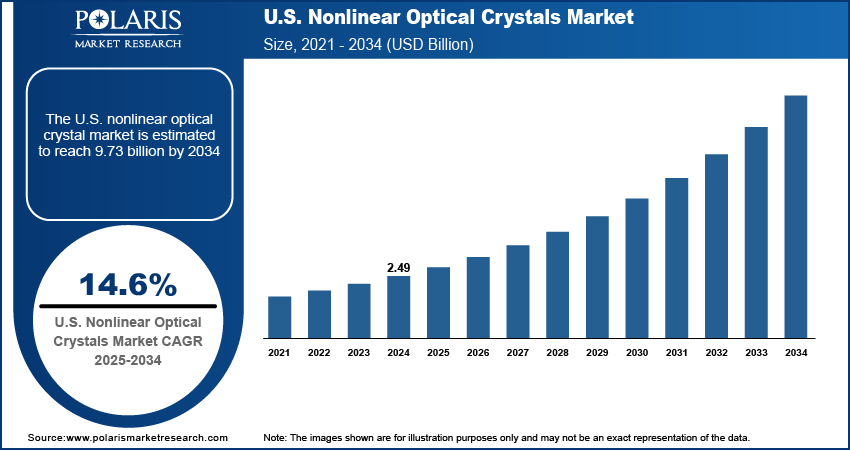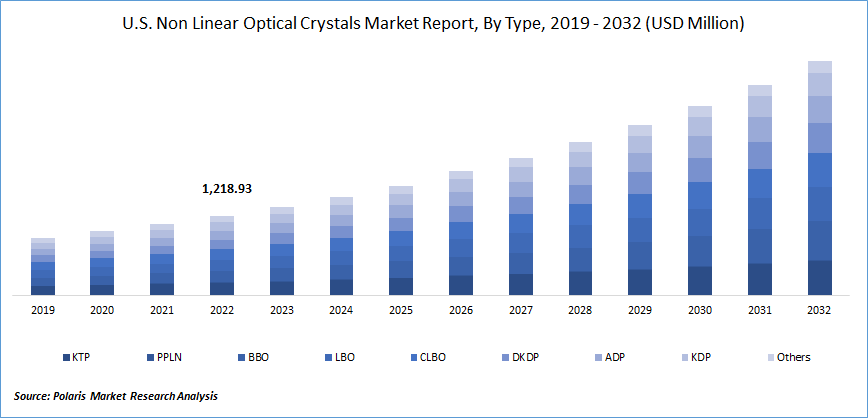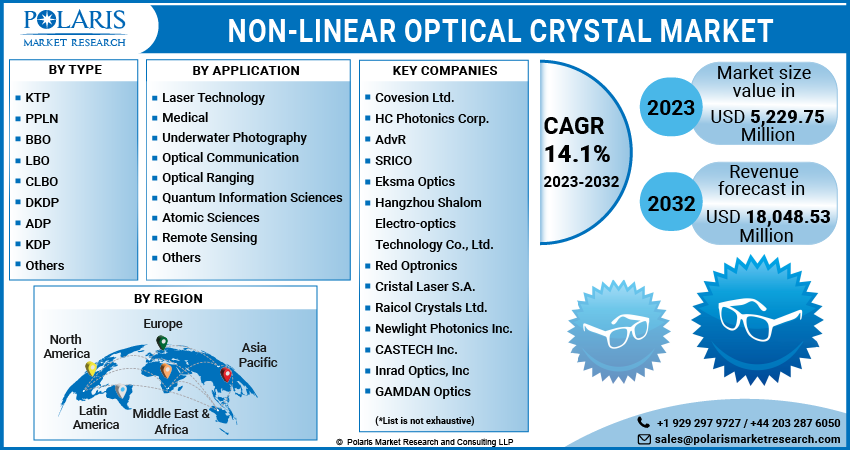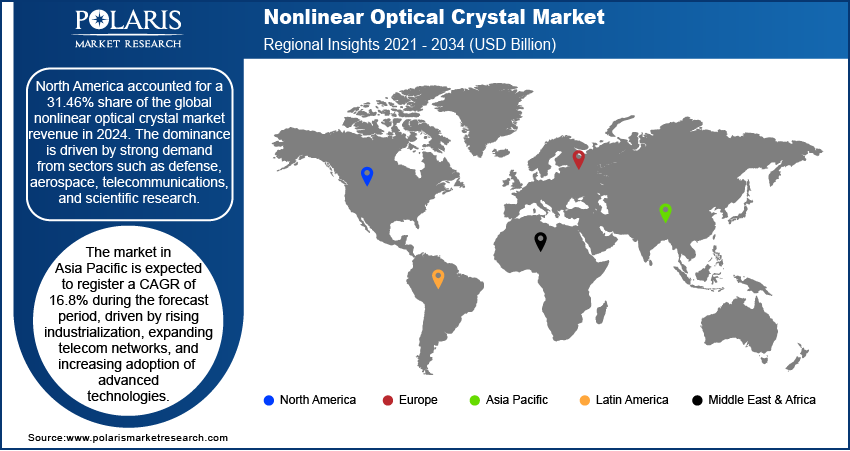
Nonlinear Optical Crystal Market Size, Share, Trends, Industry Analysis Report
By Type (KTP, PPLN), By Application, By Region – Market Forecast, 2025–2034
- Published Date:Sep-2025
- Pages: 126
- Format: PDF
- Report ID: PM1639
- Base Year: 2024
- Historical Data: 2020-2023
Overview
The global nonlinear optical crystal market size was valued at USD 5.92 billion in 2024, growing at a CAGR of 14.1% from 2025 to 2034. Key factors driving demand is rising urbanization, increasing awareness about health & safety risks, and growing rate of accidents.
Key Insights
- The KTP segment is anticipated to register a CAGR of 13.3% during the forecast period, owing to its superior efficiency in frequency doubling and strong nonlinear optical performance.
- In 2024, the atomic sciences segment accounted for 5.97% of total revenue. The dominance is driven by the use of nonlinear optical (NLO) crystals in laser cooling, atom trapping, and manipulation—key techniques in quantum physics and atomic clock development.
- North America held 31.46% of the global nonlinear optical crystal market revenue in 2024, supported by strong demand from defense, aerospace, telecommunications, and scientific research sectors.
- The U.S. contributed to 80.51% of North America's revenue in 2024, reflecting its leadership in defense, telecom, and scientific innovation.
- The Asia Pacific market is projected to register a CAGR of 16.8% during the forecast period. The market growth is fueled by rapid industrialization, expanding telecom infrastructure, and increasing adoption of advanced technologies.
Industry Dynamics
- Growth in defense and aerospace applications is driving the demand.
- Increasing demand for consumer electronics is driving the market for nonlinear optical crystal.
- Emerging fields such as quantum computing, quantum communication, and integrated photonics are expected to create new opportunities for the nonlinear optical crystals industry during the forecast period.
- High production costs of nonlinear optical crystals limit the growth.
Market Statistics
- 2024 Market Size: USD 5.92 Billion
- 2034 Projected Market Size: USD 22.22 Billion
- CAGR (2025–2034): 14.2%
- North America: Largest Market Share
AI Impact on Nonlinear Optical Crystal Market
- AI enhances the precision of nonlinear optical crystal fabrication by optimizing growth parameters and detecting defects in real-time, improving yield and quality.
- Integration of AI enables predictive modeling of crystal behavior under various optical conditions, accelerating material innovation and reducing experimental costs.
- AI-driven analytics streamline supply chain and inventory management for NLO crystals, ensuring timely delivery and minimizing production bottlenecks.
- AI supports advanced simulation of nonlinear interactions, aiding in the custom design of crystals for specific applications in telecom, defense, and quantum technologies.
A nonlinear optical (NLO) crystal is a material whose optical properties change in response to high-intensity light, enabling interactions such as frequency doubling, mixing, or shifting of laser light. These crystals are essential in converting laser wavelengths for applications in telecommunications, medical imaging, and laser-based systems. A few common examples include BBO, KTP, and LBO crystals, known for their high efficiency and stability in nonlinear processes.
Nonlinear optical crystals are used in various medical imaging technologies such as optical coherence tomography and multiphoton microscopy. These techniques allow doctors and researchers to examine tissues and cells in great detail, supporting early diagnosis and medical research. The demand for high-quality NLO crystals increases as the healthcare industry invests in more accurate, noninvasive diagnostic tools. Their ability to manipulate laser wavelengths improves image clarity and depth, making them essential in advanced biomedical systems. The trend toward personalized medicine and minimally invasive diagnostics further fuels this demand.

Emerging fields such as quantum computing, quantum communication, and integrated photonics are creating new opportunities for nonlinear optical crystals. These crystals are essential in generating entangled photons and performing wavelength conversion. The demand for specialized NLO materials is expanding as research progresses and commercial interest grows. Their role in enabling next-generation computing and secure communication technologies makes them a focus for both startups and major tech companies. Moreover, continuous investment in R&D is further fueling the boundaries of what NLO crystals can do in these advanced applications, thereby boosting the expansion.
Drivers & Opportunities
Growth in Defense and Aerospace Applications: The defense & aerospace industry is growing due to rising investments by governments and increasing demand for air travel. According to the U.S. Department of Defense, the government funded USD 3.1 billion for F-47 Next Generation. Defense and aerospace industries use laser systems for applications such as range finding, target designation, missile guidance, and directed-energy weapons. Nonlinear optical crystals are key to enabling these laser systems to operate at different wavelengths and higher powers. The increasing focus on modern warfare and advanced surveillance systems has led to greater investment in optical technologies, especially those that improve performance in extreme environments. NLO crystals that deliver precision and durability are becoming more in demand as governments and defense contractors seek high-reliability components, thereby fueling the growth.
Increasing Demand for Consumer Electronics: Consumer electronics such as 3D sensing in smartphones, augmented reality (AR) devices, and LiDAR sensors in autonomous vehicles rely on compact and efficient optical components. Nonlinear optical crystals help miniaturize laser systems and improve their functionality in these products. The need for advanced optics that enable light manipulation at the micro level continues to rise as devices become smarter and more connected. Manufacturers are turning to high-performance NLO crystals to support innovation and maintain a competitive edge with consumers demanding faster, more accurate, and feature-rich electronics, thereby driving the growth.

Segmental Insights
Type Analysis
Based on type, the segmentation includes KTP, PPLN, BBO, LBO, CLBO, DKDP, ADP, KDP, and others. The KTP segment is projected to register a CAGR of 13.3% during the forecast period due to their excellent efficiency in frequency doubling and nonlinear performance. They operate well at room temperature and are especially stable, making them ideal for long-term and high-precision laser applications. The rising demand for compact and efficient green laser sources in medical, military, and consumer devices is driving the need for KTP crystals. Their ability to convert infrared laser light into visible light efficiently supports their use in handheld laser devices, optical instruments, and holography, boosting the segment growth.
The BBO segment is expected to witness a significant share over the forecast period due to their broad phase-matching range and high damage threshold, making it suitable for high-power laser applications. They are commonly used in scientific research, micromachining, and medical laser systems. Additionally, the growing need for ultra-fast lasers and short-pulse lasers used in photonics research and advanced manufacturing further fuels the demand. Industries seek higher precision and power handling capabilities in their optical systems. Hence, BBO crystals are preferred for their reliability and performance, especially in environments requiring high stability and efficiency.
Application Analysis
In terms of application, the segmentation includes laser technology, medical, underwater photography, optical communication, optical ranging, quantum information sciences, atomic sciences, remote sensing, and others. The laser technology segment held 24.91% of revenue share in 2024, driven by its widespread use in manufacturing, medicine, defense, and communications. Nonlinear crystals such as KTP and BBO are essential in converting laser wavelengths, allowing lasers to be customized for different tasks such as cutting, imaging, or communication. The demand for advanced NLO crystals rises as industries push for more energy-efficient, compact, and high-performance laser systems. The development of femtosecond lasers, fiber lasers, and solid-state lasers further fuels the need for precise and reliable nonlinear materials, thereby driving the growth.
The atomic sciences segment held a significant revenue share of 5.97% in 2024. In atomic sciences, NLO crystals are used for laser cooling, trapping, and manipulating atoms, which are crucial techniques in quantum physics and atomic clocks. The increasing research in quantum computing and fundamental physics experiments that require precise control of light-matter interaction is fueling the growth. The demand for nonlinear crystals capable of generating and controlling coherent light at specific wavelengths grows as governments and institutions invest in next-generation atomic-level technologies, boosting the segment growth.

Regional Analysis
The North America nonlinear optical crystal market accounted for 31.46% of the global revenue share in 2024. The dominance is driven by strong demand from sectors such as defense, aerospace, telecommunications, and scientific research. The presence of major laser system manufacturers, government-funded research programs, and advanced photonics labs fuels continuous innovation. Additionally, the region's focus on upgrading military laser technologies and expanding fiber-optic networks boosts the need for high-performance NLO materials. Moreover, investments in quantum technologies and advanced medical imaging further increase demand for precision crystals, thereby fueling the growth.
U.S. Nonlinear Optical Crystal Market Insights
The U.S. held 80.51% of the revenue share in North America in 2024, due to its dominant role in defense, telecommunications, and scientific innovation. Federal funding for quantum research, national security initiatives, and high-tech healthcare tools drives significant demand for nonlinear optical components. Companies and universities across the country are developing next-generation laser systems, requiring advanced crystals such as BBO and KTP for frequency conversion and stability. Moreover, the growing use of lasers in surgeries, diagnostics, and manufacturing supports the market growth.
Asia Pacific Nonlinear Optical Crystal Market Trends
The market in Asia Pacific is expected to register a CAGR of 16.8% during the forecast period, driven by rising industrialization, expanding telecom networks, and increasing adoption of advanced technologies. Countries such as Japan, South Korea, and India are investing heavily in photonics, laser manufacturing, and consumer electronics, were nonlinear crystal’s crucial role. The region’s booming automotive and electronics industries, particularly in LiDAR and sensing applications, further drive demand. Additionally, government initiatives promoting domestic semiconductor and quantum research projects are accelerating crystal development, fueling the growth.
China Nonlinear Optical Crystal Market Overview
The demand in China is rising due to its large investments in photonics, defense, and quantum technologies. The country's strong focus on becoming self-reliant in advanced materials has led to increased domestic production of BBO, KTP, and other NLO crystals. High demand from the 5G rollout, optical communication, laser manufacturing, and LiDAR in autonomous vehicles fuels growth. Additionally, China is funding quantum computing and atomic research, which rely on precision laser systems supported by NLO materials. Moreover, government support and a large industrial base boost the growth.
Europe Nonlinear Optical Crystal Market Analysis
The industry in Europe is projected to register a CAGR of 14.1% from 2025 to 2034, driven by its strong presence in research, photonics, and advanced manufacturing. The region is home to world-class universities, laser technology firms, and aerospace companies that rely on high-precision NLO materials. EU-funded initiatives such as Horizon Europe and Quantum Flagship are promoting innovation in quantum communication, photonic computing, and laser science. Additionally, the region’s push toward green technologies and smart manufacturing encourages the use of laser-based systems, boosting demand for efficient and durable crystals such as BBO and KTP across multiple industries, thereby driving the growth.
Germany Nonlinear Optical Crystal Market Assessment
The industry in Germany is projected to register a CAGR of 14.0% from 2025 to 2034, due to country's strong focus on Industry 4.0 has led to increased adoption of high-performance laser systems in manufacturing, driving demand for NLO crystals used in frequency conversion and beam control. Germany is further deeply involved in quantum research and photonics, supported by national and EU-level funding. Leading German companies and institutions are advancing laser-based healthcare, automotive LiDAR, and scientific instrumentation all of which depend on reliable nonlinear materials, thereby driving the growth.

Key Players & Competitive Analysis
The industry is highly specialized and moderately fragmented, driven by innovation, quality, and customization. Key players such as Covesion Ltd.; HC Photonics Corp.; AdvR; SRICO; Eksma Optics; Hangzhou Shalom Electro-optics Technology Co., Ltd.; Cristal Laser S.A.; Raicol Crystals Ltd.; Newlight Photonics Inc.; Inrad Optics, Inc.; GAMDAN Optics; Gooch & Housego; and WTS PHOTONICS CO., LTD. together represent a substantial share of the global market. These firms compete by advancing crystal purity, damage thresholds, and phase-matching accuracy. For example, Eksma Optics and Cristal Laser lead in ultra-low-loss and high-damage-threshold crystals, targeting high-power lasers and defense applications. Companies such as Raicol excel in quasi-phase-matched crystals such as PPLN, capturing major telecom and LiDAR markets. Meanwhile, players in Asia such as Hangzhou Shalom and HC Photonics are gaining traction through cost-effective, robust offerings, especially in consumer-electronics and industrial sectors. Overall, competition is rooted in material innovation, regional strengths, and application-specific excellence.
Key Players
- AdvR
- Covesion Ltd.
- Cristal Laser S.A.
- Eksma Optics
- GAMDAN Optics
- Gooch & Housego
- Hangzhou Shalom Electro-optics Technology Co., Ltd.
- HC Photonics Corp.
- Inrad Optics, Inc.
- Newlight Photonics Inc.
- Raicol Crystals Ltd.
- SRICO
- WTS PHOTONICS CO., LTD
Nonlinear Optical Crystal Market Segmentation
By Type Outlook (Revenue, USD Billion, 2021–2034)
- KTP
- PPLN
- BBO
- LBO
- CLBO
- DKDP
- ADP
- KDP
- Others
By Application Outlook (Revenue, USD Billion, 2021–2034)
- Laser Technology
- Medical
- Underwater Photography
- Optical Communication
- Optical Ranging
- Quantum Information Sciences
- Atomic Sciences
- Remote Sensing
- Others
By Regional Outlook (Revenue, USD Billion, 2021–2034)
- North America
- U.S.
- Canada
- Europe
- Germany
- France
- UK
- Italy
- Spain
- Netherlands
- Russia
- Rest of Europe
- Asia Pacific
- China
- Japan
- India
- Malaysia
- South Korea
- Indonesia
- Australia
- Vietnam
- Rest of Asia Pacific
- Middle East & Africa
- Saudi Arabia
- UAE
- Israel
- South Africa
- Rest of Middle East & Africa
- Latin America
- Mexico
- Brazil
- Argentina
- Rest of Latin America
Nonlinear Optical Crystal Market Report Scope
|
Report Attributes |
Details |
|
Market Size in 2024 |
USD 5.92 Billion |
|
Market Size in 2025 |
USD 6.74 Billion |
|
Revenue Forecast by 2034 |
USD 22.22 Billion |
|
CAGR |
14.1% from 2025 to 2034 |
|
Base Year |
2024 |
|
Historical Data |
2021–2023 |
|
Forecast Period |
2025–2034 |
|
Quantitative Units |
Revenue in USD Billion and CAGR from 2025 to 2034 |
|
Report Coverage |
Revenue Forecast, Competitive Landscape, Growth Factors, and Industry Trends |
|
Segments Covered |
|
|
Regional Scope |
|
|
Competitive Landscape |
|
|
Report Format |
|
|
Customization |
Report customization as per your requirements with respect to countries, regions, and segmentation. |
FAQ's
The global market size was valued at USD 5.92 billion in 2024 and is projected to grow to USD 22.22 billion by 2034.
The global market is projected to register a CAGR of 14.2% during the forecast period.
North America dominated the market in 2024.
A few of the key players in the market are Covesion Ltd.; HC Photonics Corp.; AdvR; SRICO; Eksma Optics; Hangzhou Shalom Electro-optics Technology Co., Ltd.; Cristal Laser S.A.; Raicol Crystals Ltd.; Newlight Photonics Inc.; Inrad Optics, Inc.; GAMDAN Optics; Gooch & Housego; and WTS PHOTONICS CO., LTD.
The KTP segment dominated the market revenue share in 2024.
The atomic sciences segment is projected to witness the fastest growth during the forecast period.
